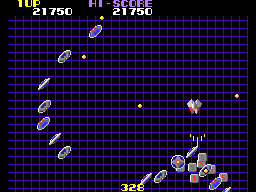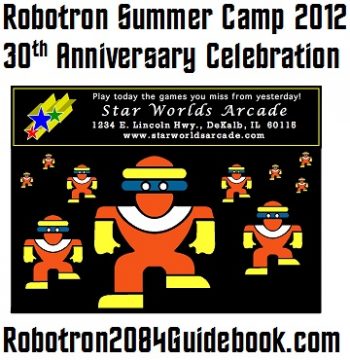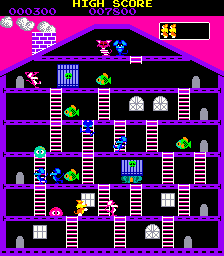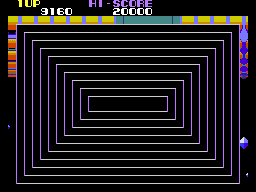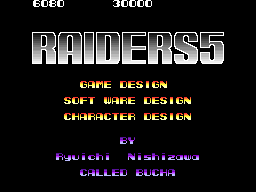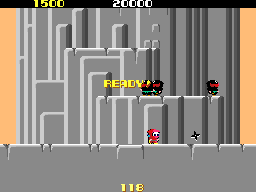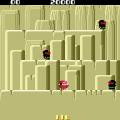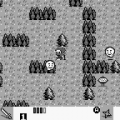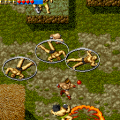UPL Corporation (“Universal Play Land”) was at the forefront of the Japanese arcade development scene. Though relatively obscure outside of Japan, inside the country they are well known for classics such as Majou no Bouken: Ninja-kun, NOVA2001, Gomola Speed, and Penguin-kun Wars. Many of these are currently available for download on the PlayStation 4 as part of the Arcade Archives series. We spoke to Ryuichi Nishizawa, who was an early employee of the company and worked on four titles, before he left and founded Escape/Westone.
To start, what games did you work on at UPL, and what roles did you play?
When I was nineteen, I left Tehkan and joined UPL. At that time, UPL had just started the development department. The department had only two technical staff, including me.
The first task after I joined was the development of an arcade game called Mouser. Based on the program of Nintendo’s hit arcade game Donkey Kong, it was developed by two people. My role was everything other than the main program. That is, game design, graphic design, and sound. The first thing I programmed was a BGM sequencer. (ED note: the soundtrack to Mouser is the classic song “Turkey in the Straw”.)
Then, the development staff was expanded, and UPL designed its own original arcade board. NOVA2001 was developed for this PCB. It could support up to 64 sprites, so in order to demonstrate the performance for this new board, we decided to create a shooting game. I was responsible for game design, character design, and programming.
Next I developed the action game Majou no Bouken: Ninja-kun. The hardware was more advanced than NOVA2001. As with the previous project, I was in charge of the game design, character design, background design, and all programming. From this time, the company was further increasing staff, so I shared work with other projects.
The last game I developed at UPL was RAIDERS5. This game was completed over a short period of just four months using the same board as Ninja-kun. I was responsible for everything but the sound.
What kind of hardware did UPL use? Was it difficult to learn how to design and program on it?
The hardware for NOVA2001 was an original board by UPL. It was designed by Mr. Nobuyuki Narita’s engineers. I think he designed all of the boards for UPL. I believe he left the company to work at NMK Inc and was in charge of board design there too.
Before joining UPL I knew a little bit about programming. Looking at the code written by other programmers, I learned on my own. NOVA2001 was the first game I programmed.
What were some of your favorite early arcade games, either from Japan or America?
Of Japanese arcade games, I liked Namco’s titles. Pac-Man, Mappy, Dig Dug, Galaga, Gaplus, Dragon Buster, Xevious, I loved all of the stuff from Namco’s golden age. The music in particular was great.
I also liked American games. My favorite is Atari’s Star Wars. I must have played it about a million times. I really want to buy the latest Star Wars: Battle Pod. Additionally, I’m a fan of Eugene Jarvis. He developed Defender and Robotron 2084, which are really cool. They have fantastic sound too! I bought a t-shirt for Robotron 2084‘s 30th Anniversary. (laughes)
What were some of your other favorite UPL games?
I like Penguin-kun Wars. After the development of Ninja-kun, UPL increased their in-house staff to two teams. I was in charge of RAIDERS5, Tsutomu Fujisawa’s team made Penguin-kun Wars. Back then, a game starring such adorable characters was pretty unusual, and I thought it was bold to commercialize it.
What was the inspiration for Mouser? It seems like Donkey Kong but still very different.
At that time in UPL, no one knew how to develop a game. The company even told us that we just had to change the characters while stealing the entire game design of Donkey Kong. But naturally we didn’t think it was safe and we managed to complete the product after much trial and error. To be honest, we could not blame even if someone considered the development process of the game to be just a copy of Donkey Kong. That’s because we developed Mouser by analyzing the ROM of Donkey Kong to learn how to create a game. I think that this kind of development method was commonly taken in many of the Japanese game companies in the era.
What was the inspiration behind NOVA2001? At first it seems like Galaga, but the 360 degree movement makes it feel more like Robotron 2084. (Plus the explosion and stage warping effects are very similar!)
As you pointed out, Robotron 2084 had a significant influence on NOVA2001. I wanted to create a 360 degree omni-directional shooter such as Robotron 2084. However, due to the cabinet design that was common in Japan at the time, we were unable to put in dual joysticks. So by pressing a button, you could fix your ship’s orientation. The “stage clear” effect was a conscious imitation of Robotron 2084. That used full graphic system hardware, but this used character generator system hardware, so I was unable to replicate it exactly, but I think it looks close enough. (laughs) I used a lot of trial and error to replicate the “Gyuoon, Gonononono” sound effects. The sound hardware was completely different, but again I was able to create something that was not exactly the same, but close enough. (laughs)
Were you consulted for the development of the sequel, Ark Area?
Nope, I was not contacted at all. In fact, it wasn’t until recently that I learned it was the sequel to NOVA2001. (laughs)
How did you begin to develop RAIDERS5? What inspired a “puzzle-shooter” game?
The game design of RAIDERS5 was not inspired by anything, but it was completely our own idea. Firstly the company ordered us to develop a game in a short period. I had some existing designs of characters for shooters, so I decided to use them to create a game that needed as little artwork as possible. That’s why we settled on a puzzle shooter. We had no clear idea about the rules of the puzzle from the beginning, and we were making the rules while developing the game. We built up the game design step by step, making a few parts of the game, test-playing it, and revising the design or adding more ideas.
The introduction to RAIDERS5 actually has the credits, that’s very unusual for a Japanese arcade game! How was UPL able to allow this? Also, who is “CALLED BUCHA”?
“BUCHA” is my nickname I used in games. It was the name I used to enter into high score tables in arcade games. The full name cannot fit into three characters, so I entered the name as BUC. “BUCHA” was my nickname from my student days.
UPL was very generous to its development staff. In particular, there were no requirements about the contents of the game. They had a culture where creators could pitch ideas freely. Therefore, it was not a problem to feature our names in a game. I wanted to advertise in the demo loops that these games were developed by two people. Indeed, that might not have been possible at other companies. (laughes)
NOVA2001 and RAIDERS5 were sci-fi, so what prompted the change to a comical action game with Ninja-kun?
When I started development on Ninja-kun, I wanted to capture the feeling of Namco’s Mappy, which was in an arcade by my house. Of course, Xevious was their next big hit. But Mappy was one game I really loved. The character design and the music was just the best. I would play every day to aim for the top scores. When I had the opportunity, that’s when I started Ninja-kun.
In Pac-Man, Mappy, and Dig Dug, the idea is that the cute character will die when they come in contact with the enemy. Donkey Kong and Mario Bros. are also the same. The thrill of evading enemies makes for a very fun game, but it’s also very stressful, and can end up being very frustrating. So I thought “I wish there was an action game where you don’t die if you touch the enemy”, and that was the beginning of Ninja-kun.
Is there any relation between Ninja-kun, released for the PC-88 and MSX by Microcabin?
There is absolutely no relation to Microcabin’s Ninja-kun. The title being the same is purely a coincidence.
This is a more general question, but why are the Daruma dolls enemies? I remember seeing these as enemies in video games when I was very young (like in Alex Kidd) but until I was older I didn’t know what they were!
Daruma might be unfamiliar to people outside of Japan. They are ornaments used for auspicious occasions, which are familiar to Japanese people. Business people even today decorate their house with them. Although, not in my house. (laughes)
The enemy characters in Ninja-kun are Japanese-style monsters. Certainly the daruma is not a monster, but I used it as a character because of the high profile as something distinctly Japanese. Since the daruma has a scary face, it’s perfect for an enemy character. Also, because the design is simple, it’s easy to create a pixel rendition.
Ninja-kun has some cool effects, like the colorful scenery between stages and the cherry blossoms when you run out of lives, what inspired these?
“Sakura” is the Japanese spring tradition. The Japanese have a special feeling for the cherry blossoms. Cherry trees bloom all at once for only for a very short period of time. After full bloom, the cherry blossoms will fall. How the petals flutter to the ground is a traditional rendition that we use in Japan when you express the sentiment that life is gradually scattering.
What is the relation between UPL’s Ninja-kun and Jaleco’s Ninja Jajamaru-kun?
The Nintendo Famicom was released in 1983. The arcade version of Ninja-kun was released in 1984. Most Famicom software at the time were ports of hit arcade games. At the time, UPL did not have much interest in the home console market, so they sold the license for Ninja-kun to Jaleco. The Famicom version of this title was a big hit. When discussing Famicom software, people seem to speak very highly of it. Looking back on it now, I wonder if it was a waste for UPL to not develop and publish the port themselves.
In 1985, Jaleco developed Ninja Jajamaru-kun on their own. Jajamaru-kun seems to be the brother of Ninja-kun. Since the presidents of UPL and Jaleco had a good relationship, I honestly think he allowed him to expand the franchise.
UPL had many interesting games in the mid-1980s, but their output seemed less inspired as time went on into the 90s, before it closed. Why did they change direction?
Since I left UPL immediately after completing RAIDERS5, I do not know much about what happened in-house afterwards, because I was busy building my own company. Many arcade games after I left UPL were created by Tsutomu Fujisawa. For better or worse, his game design is very unique. I think that is emblematic of UPL’s work. If anything about the game’s direction changed, it was because of him. (ED Note: According to Wikipedia, Fujisawa developed the Ninja-kun sequel and then left UPL in 1987 to become a freelancer, though he continued to work with UPL on many later projects.)
Finally, Majou no Bouken: Ninja-kun was created 30 years ago. I am very pleased that it has been accurately ported to the PS4. If you have only played the Famicom version, please try the original arcade game. You will be able to enjoy more sophisticated play than the FC version. Because the enemy of the final stage is the “alter ego of the player”, please check it out.
Thanks to Hanenashi Error for the translation help!


